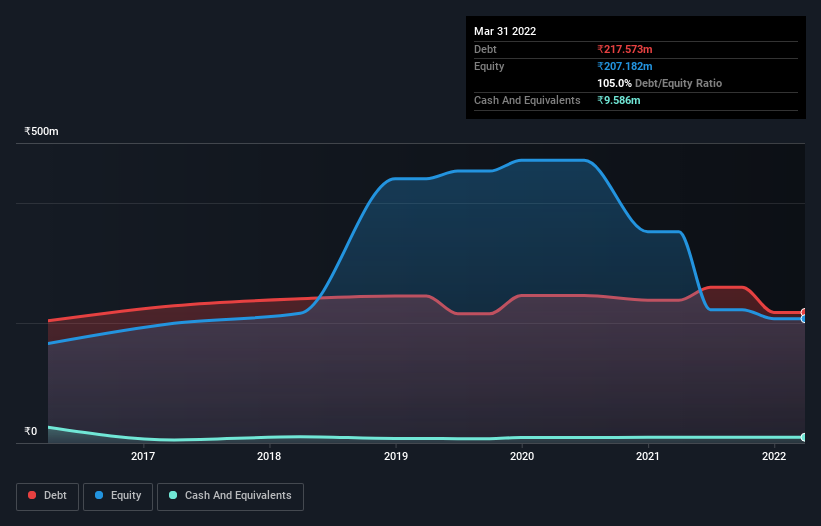Jakharia Fabric (NSE:JAKHARIA) Is Carrying A Fair Bit Of Debt
David Iben put it well when he said, 'Volatility is not a risk we care about. What we care about is avoiding the permanent loss of capital.' When we think about how risky a company is, we always like to look at its use of debt, since debt overload can lead to ruin. We can see that Jakharia Fabric Limited (NSE:JAKHARIA) does use debt in its business. But the real question is whether this debt is making the company risky.
Why Does Debt Bring Risk?
Generally speaking, debt only becomes a real problem when a company can't easily pay it off, either by raising capital or with its own cash flow. Ultimately, if the company can't fulfill its legal obligations to repay debt, shareholders could walk away with nothing. While that is not too common, we often do see indebted companies permanently diluting shareholders because lenders force them to raise capital at a distressed price. By replacing dilution, though, debt can be an extremely good tool for businesses that need capital to invest in growth at high rates of return. The first thing to do when considering how much debt a business uses is to look at its cash and debt together.
Check out our latest analysis for Jakharia Fabric
How Much Debt Does Jakharia Fabric Carry?
You can click the graphic below for the historical numbers, but it shows that Jakharia Fabric had ₹217.6m of debt in March 2022, down from ₹238.0m, one year before. However, it does have ₹9.59m in cash offsetting this, leading to net debt of about ₹208.0m.

How Strong Is Jakharia Fabric's Balance Sheet?
According to the last reported balance sheet, Jakharia Fabric had liabilities of ₹354.1m due within 12 months, and liabilities of ₹174.2m due beyond 12 months. Offsetting these obligations, it had cash of ₹9.59m as well as receivables valued at ₹139.5m due within 12 months. So it has liabilities totalling ₹379.2m more than its cash and near-term receivables, combined.
This deficit is considerable relative to its market capitalization of ₹508.0m, so it does suggest shareholders should keep an eye on Jakharia Fabric's use of debt. Should its lenders demand that it shore up the balance sheet, shareholders would likely face severe dilution. There's no doubt that we learn most about debt from the balance sheet. But it is Jakharia Fabric's earnings that will influence how the balance sheet holds up in the future. So when considering debt, it's definitely worth looking at the earnings trend. Click here for an interactive snapshot.
Over 12 months, Jakharia Fabric reported revenue of ₹751m, which is a gain of 82%, although it did not report any earnings before interest and tax. Shareholders probably have their fingers crossed that it can grow its way to profits.
Caveat Emptor
While we can certainly appreciate Jakharia Fabric's revenue growth, its earnings before interest and tax (EBIT) loss is not ideal. Indeed, it lost ₹20m at the EBIT level. When we look at that and recall the liabilities on its balance sheet, relative to cash, it seems unwise to us for the company to have any debt. Quite frankly we think the balance sheet is far from match-fit, although it could be improved with time. Another cause for caution is that is bled ₹65m in negative free cash flow over the last twelve months. So in short it's a really risky stock. The balance sheet is clearly the area to focus on when you are analysing debt. But ultimately, every company can contain risks that exist outside of the balance sheet. To that end, you should be aware of the 4 warning signs we've spotted with Jakharia Fabric .
Of course, if you're the type of investor who prefers buying stocks without the burden of debt, then don't hesitate to discover our exclusive list of net cash growth stocks, today.
New: Manage All Your Stock Portfolios in One Place
We've created the ultimate portfolio companion for stock investors, and it's free.
• Connect an unlimited number of Portfolios and see your total in one currency
• Be alerted to new Warning Signs or Risks via email or mobile
• Track the Fair Value of your stocks
Have feedback on this article? Concerned about the content? Get in touch with us directly. Alternatively, email editorial-team (at) simplywallst.com.
This article by Simply Wall St is general in nature. We provide commentary based on historical data and analyst forecasts only using an unbiased methodology and our articles are not intended to be financial advice. It does not constitute a recommendation to buy or sell any stock, and does not take account of your objectives, or your financial situation. We aim to bring you long-term focused analysis driven by fundamental data. Note that our analysis may not factor in the latest price-sensitive company announcements or qualitative material. Simply Wall St has no position in any stocks mentioned.
About NSEI:JAKHARIA
Jakharia Fabric
Engages in the dyeing and processing of fabrics in India.
Solid track record with excellent balance sheet.
Similar Companies
Market Insights
Community Narratives



